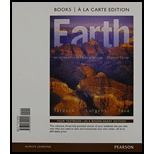
The factors influencing the amount of rain soaking into the ground compared to the amount that will run off.
Answer to Problem 1GST
The precipitation water infiltrating into the ground or undergoing runoff directly depend on various factors which mainly encompass the (a) degree of saturation of the soil, (b) duration and intensity of rainfall, (c) slope of the terrain, (d) nature of surface material and (e) nature, typeand amount of vegetation.
Explanation of Solution
The precipitation reaching the land surface can infilter into the ground or can run down to the streams, lakes, rivers or oceans on the basis of precipitation rates and saturation of ground. Infiltration is the phenomenon through which water penetrates from the surface into it. When water flows over the surface and joins the other water bodies, it may be defined as runoff.
Both the process vary with time and location depending on different factors. If the soil is already saturated with enough water and is incapable of taking in more water, infiltration is no more a possibility and so the remaining water runs off to join the waterbodies. The reverse condition during which the soil is not saturated, then water infiltrates into the surface.
When the rainfall is so heavy and it lasts for many hours, the soil turns saturated with water. Then the precipitation rate goes beyond the infiltration rate. In such a situation, the process that take place is runoff. A sloppy terrain does not allow much water infiltration, it causes the water to runoff because of its slanting or sloppy nature. Water has the tendency to flow from a high elevation to a lower elevation. This it flows down a slope easily.
When the composing materials of a ground is porous and permeable, then it allows more water to penetrate into the ground, raising the infiltrationrate. On contrary if the ground is impermeable or is covered with impervious roads, parking spacesand buildings, it disrupts the infiltration and runoff proceeds.
An area with thick and vast vegetation has the capacity to absorb more water. The plant roots absorb water which they use for their food production and metabolicactivities. They also retain the water on the ground for more time. Thus they promote more infiltration than run off. Certain vegetation would not be capable of holding water. Such vegetation promotes runoff.
Want to see more full solutions like this?
Chapter 16 Solutions
Earth: An Introduction To Physical Geology (Looseleaf) - With Access
 Applications and Investigations in Earth Science ...Earth ScienceISBN:9780134746241Author:Edward J. Tarbuck, Frederick K. Lutgens, Dennis G. TasaPublisher:PEARSON
Applications and Investigations in Earth Science ...Earth ScienceISBN:9780134746241Author:Edward J. Tarbuck, Frederick K. Lutgens, Dennis G. TasaPublisher:PEARSON Exercises for Weather & Climate (9th Edition)Earth ScienceISBN:9780134041360Author:Greg CarbonePublisher:PEARSON
Exercises for Weather & Climate (9th Edition)Earth ScienceISBN:9780134041360Author:Greg CarbonePublisher:PEARSON Environmental ScienceEarth ScienceISBN:9781260153125Author:William P Cunningham Prof., Mary Ann Cunningham ProfessorPublisher:McGraw-Hill Education
Environmental ScienceEarth ScienceISBN:9781260153125Author:William P Cunningham Prof., Mary Ann Cunningham ProfessorPublisher:McGraw-Hill Education Earth Science (15th Edition)Earth ScienceISBN:9780134543536Author:Edward J. Tarbuck, Frederick K. Lutgens, Dennis G. TasaPublisher:PEARSON
Earth Science (15th Edition)Earth ScienceISBN:9780134543536Author:Edward J. Tarbuck, Frederick K. Lutgens, Dennis G. TasaPublisher:PEARSON Environmental Science (MindTap Course List)Earth ScienceISBN:9781337569613Author:G. Tyler Miller, Scott SpoolmanPublisher:Cengage Learning
Environmental Science (MindTap Course List)Earth ScienceISBN:9781337569613Author:G. Tyler Miller, Scott SpoolmanPublisher:Cengage Learning Physical GeologyEarth ScienceISBN:9781259916823Author:Plummer, Charles C., CARLSON, Diane H., Hammersley, LisaPublisher:Mcgraw-hill Education,
Physical GeologyEarth ScienceISBN:9781259916823Author:Plummer, Charles C., CARLSON, Diane H., Hammersley, LisaPublisher:Mcgraw-hill Education,





